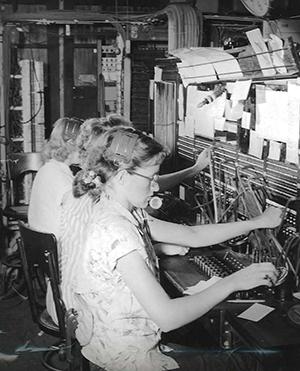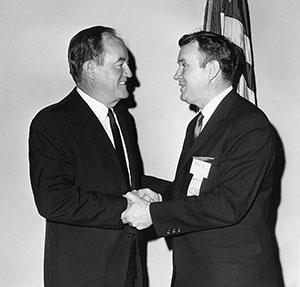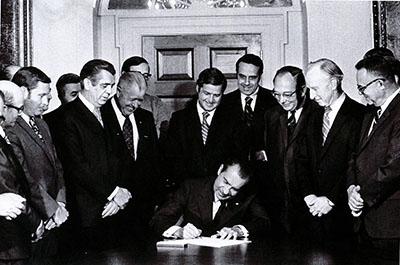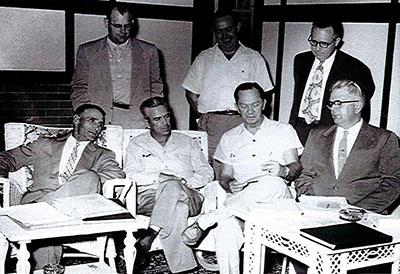History of Rural Telecommunications
The independent telephone industry began to develop throughout rural America early in the 1890s. After the publication of a manual that explained to farmers how they could develop their own telephone systems on a mutual or cooperative basis, many farmer mutual systems emerged throughout rural America. By 1912, the number of rural telephone systems had grown to more than 3,200, and the U.S. telephone industry included several manufacturers that specialized in the production of so-called "rural phones."
The number of farmer lines continued to increase after World War I. At its high point in 1927, the rural telephone industry included some 6,000 mutual systems and other organizations. But during the same period, these systems were deteriorating: Many failed to keep adequate accounts; subscribers were lax about paying bills; and there were few maintenance people and little regular upkeep of the facilities. Poor service became the standard in rural America..
Read More
The 1930s brought about the New Deal and the establishment of the "alphabet agencies," including the Federal Communications Commission (FCC), which was created by the Communications Act of 1934. The act also made the concept of universal service the law of the land. This cornerstone of telecommunications policy called for "making available, so far as possible, to all the people of the United States a rapid, efficient, nationwide and worldwide wire and radio communication service with adequate facilities at reasonable charges..."
The goal of universal service was—and remains today—to ensure that all Americans, regardless of where they live, receive quality communications service at reasonable rates. (Initially the focus was on voice service but beginning in the later part of the twentieth century, the focus would expand to include broadband and voice service.)
By 1940, the farmer systems had deteriorated to a point where fewer farmers had telephones than in 1920. In late 1944, a bill was introduced in the U.S. Senate to establish a Rural Telephone Administration modeled after the already successful Rural Electrification Administration (REA). Action finally came in 1949 on bills to amend the Rural Electrification Act, making long-term, low-interest loans available to rural telephone systems. The availability of low-interest loans sparked a new era of growth for rural telephony, which continues today. More importantly, the availability of high-quality telephone service at reasonable rates improved the quality of life for millions of rural Americans.
The Early Years of NTCA
After the establishment of the REA telephone loan program in 1949, the National Rural Electric Cooperative Association (NRECA) formed a telephone committee, composed of representatives of emerging joint electric-telephone cooperative organizations. In 1954, the committee decided that the time had come to form a separate national organization to represent telephone cooperatives. NTCA, originally known as the National Telephone Cooperative Association, was incorporated on June 1, 1954, and eight rural telephone systems in seven states became the original members. Membership would grow quickly, reaching 100 rural telephone cooperatives by the 1960s.
At its birth, NTCA concentrated on promoting additional memberships and testifying in annual congressional REA appropriations hearings. Initially, all work was undertaken either by the individual members of the NTCA Board of Directors or by NRECA staff. In 1958, NTCA hired its first full-time staff member and it was around that time that the board of directors entered into an arrangement with NRECA to make the rural electric insurance and benefit programs available to employees of NTCA-member telephone cooperatives...
Read More
In the 1960s, NTCA focused on offering an increasing variety of services to its members and additional staff was added. The principal concern of the association continued to be the availability of adequate REA loan funds to meet the needs of rural telephone systems. NTCA took the lead in helping to develop supplemental sources of financing to meet the needs of rural telco borrowers. The association advocated for a supplemental bank for rural telephone systems, and in 1971, Congress established the Rural Telephone Bank.
The 1970s were a time of substantial growth for the association. NTCA members voted in 1970 to allow locally owned and controlled commercial telcos to join the association as nonvoting affiliate members. By the end of the decade, the association’s membership had reached nearly 300, representing telephone companies, member affiliates and associate members.
The 1980s to the 2000s
The 1980s ushered in a new era for the industry, following the landmark court ruling in 1982 that required AT&T to divest itself of the 22 Bell operating companies. Competition became the name of the game, and NTCA members responded, delving into new product lines such as cellular, cable TV, and satellite.
New opportunities continued to emerge throughout the 1990s, none more significant than the Internet. Providing broadband internet service at higher and higher speeds became a key focus for NTCA members. Another new line of business was long-distance service...
Read More
In 1994, NTCA established the Foundation for Rural Service, which supports rural telecom companies, consumers and policymakers with educational information, products and programming. In addition to operating a community grant program, FRS also produces educational materials and has youth engagement and Congressional broadband tour programs.
NTCA was very involved in advocacy efforts leading up to—and following—the passage of the 1996 Telecommunications Act, a rewrite of the nation’s communications act, which opened up new opportunities, such as the ability for rural telcos to offer voice and internet service outside their traditional local service territory.
The 2000s brought increased competition and even more products and services. NTCA members were among the first U.S. service providers to deploy fiber broadband to maximize the broadband speeds they could deliver. As a sign of the changing times, the association officially changed its name in 2002 to the National Telecommunications Cooperative Association.
The increased importance of broadband also drove policy makers to make various changes to the Universal Service Fund program throughout the early part of the 21st century, and NTCA has been a strong advocate for rural telecom and broadband throughout that process. To support these efforts, NTCA launched a grassroots advocacy campaign, Supporting Policy Initiatives for Rural Independent Telecommunications, to encourage members to proactively build relationships with their members of Congress.
The 2010s
Another important broadband initiative for NTCA came in 2010 when the association and its rural allies launched a comprehensive Save Rural Broadband campaign to tout the critical need for broadband access for all Americans. The association also launched a strategic outreach effort to partner with third-party organizations that have an interest in ensuring rural communities are not left behind. Social media and video became increasingly useful ways of communicating, and NTCA increasingly relied on them to support members and advocate for rural telecom...
Read More
In the early 2010s, NTCA rolled out several new training and development programs, including the groundbreaking Rural Telecom Industry Meeting & EXPO (RTIME) and the Telecom Executive Policy Summit, and continues to focus on hot topics with events such as the Cybersecurity Summit. The association also made improvements and enhancements to its financial management system, and unveiled a new, user-friendly association management system that delivers online tools, such as online membership management, the ability to update company information, access to certificate transcripts and more.
In February 2013, NTCA and the Organization for the Promotion and Advancement of Small Telecommunications Companies (OPASTCO), a separate organization dedicated to representation of small telcos founded in 1963, agreed to unify, creating NTCA–The Rural Broadband Association and expanding membership to about 850.
Including the word “broadband” in the new name for the organization reflected the increased importance of the technology for rural America.
The year 2017 marked a change in presidential administration, which included a greater emphasis on rural issues and the need to invest in infrastructure, including rural infrastructure. NTCA was a strong advocate for including broadband in any infrastructure program. To support that advocacy, NTCA established a #BuildBroadbandWithUs social media campaign.
The increased importance of broadband and the decline in traditional voice lines prompted NTCA in 2018 to change its dues formula so that dues would be based on broadband subscribers, rather than on voice lines, which had been the traditional method. The purpose of the change was to ensure more predictable funding for NTCA operations.
In 2019, NTCA celebrated both the 50th anniversary of the association’s Rural Broadband PAC, previously known as TECO, and the 25th anniversary of the Foundation for Rural Service.
The 2020s
The following year marked the beginning of the COVID-19 pandemic in the U.S., which drew national attention to the importance of broadband, as school, health care and many job responsibilities were conducted online and via teleconference.
NTCA members signed on to the FCC’s Keep Americans Connected Pledge, agreeing not to disconnect customers for non-payment for several months, waiving certain late fees and making Wi-Fi hotspots available for public use. Realizing that rural areas lagged behind urban areas in high-speed broadband availability, policymakers included broadband funding in two key pieces of legislation passed in 2020, including the CARES Act and the Coronavirus Response and Relief Supplemental Appropriations Act.
Ongoing NTCA Initiatives
Over the last decade, NTCA has focused on numerous key initiatives for rural telecom that remain a key focus in the 2020s. These initiatives were driven by key developments in the industry and include universal service/ broadband, smart rural communities, cybersecurity and others.
- Universal Service and Broadband
-
Communities increasingly have realized that broadband is critical to economic development and to keeping and attracting business. Students increasingly rely on broadband connectivity, both at school and at home, and the health care industry is realizing that telehealth initiatives could help improve the quality of care for those living in rural areas. Rural areas without adequate broadband are in danger of being left behind and falling victim to what is commonly called “the digital divide.”
Universal service has become a more important focus area than ever for NTCA. An important universal service win for NTCA occurred in 2017, when the FCC allowed rural telcos to receive support for customers who only subscribe to broadband without voice service, an offering known as stand-alone broadband. This was an increasingly important issue at a time when both urban and rural customers were cancelling traditional landline voice service in favor of wireless service.
The U.S. Department of Agriculture also offered a new funding option for rural broadband for 2019 and 2020. The Rural Utilities Service for years had offered low-interest loans for the deployment of telecommunications and broadband in rural areas. The new program, known as ReConnect, made awards in the form of grants as well as loans and grant/loan combinations, targeting areas without access to high-speed broadband. Numerous NTCA members won funding through the ReConnect program.
Moving forward, a key advocacy area for NTCA is the need for longer-term universal service support for rural areas. Current universal service programs are designed to run for a limited period of time, but some rural areas will require ongoing support in order for the service provider to be able to offer service that is comparable with what is available in urban areas on both a performance and price basis. - Smart Rural Community
-
NTCA has helped promote the importance of broadband to rural America in numerous ways. One of these was the establishment in 2013 of the Smart Rural Community program, which recognizes rural communities served by broadband networks that foster innovative economic development and commerce, blue-ribbon education, first-rate health care, cutting-edge government services, robust security and more efficient energy distribution and use.
In 2019, the program was redesigned to encompass four individual initiatives, including the Smart Rural Community Provider™ branding platform; the Gig-Certified Smart Rural Community Provider™ designation, and the Smart Rural Community Showcase Awards™. Each is accompanied by tools and resources to help program participants market their cutting-edge services and celebrate their contributions to connecting more rural communities with advanced broadband communications.
The Gig-Certified Smart Rural Community Provider™ designation was a rebrand of the Gig-Certified Provider program that NTCA launched in 2015 to recognize NTCA members capable of delivering gigabit service to the vast majority of locations in an exchange. Just as they were among the first to deploy fiber broadband, NTCA members also were among the first to deploy broadband networks capable of supporting gigabit service, beginning in the early part of the 21st century. - Cybersecurity
-
The Cybersecurity Act of 2015 established the Department of Homeland Security as the portal for cyber threat information sharing with the government. NTCA members and staff support cybersecurity through their participation on the FCC Communications Security, Reliability and Interoperability Council.
In 2017, NTCA established a members-only Cybersecurity Working Group focused on policy. The same year, the association established the Cyber Wise cybersecurity information program, which provides small, rural telecommunications providers with programming and insights that can aid their development of more comprehensive cybersecurity risk management programs.
The program received a financial award from the DHS National Infrastructure Protection Plan (NIPP) Security and Resilience Challenge and the Office of Infrastructure Protection, in partnership with the National Institute for Homeland Security.
In 2019, NTCA pursued yet another cybersecurity initiative. The association received a NIPP Challenge award to support a feasibility and pilot project to create a new Cyber-Threat Information Sharing Forum for Small Network Operators. The goal was to create a central, trusted environment to enable participants to share and receive information about cyber threats, vulnerabilities, best practices and mitigation activities.
The pilot was successful and formed the basis for NTCA to launch the CyberShare cyberthreat information sharing platform for small broadband providers in 2020. In early 2021, CyberShare joined the National Council of Information Sharing and Analysis Centers, creating several new strategic partnerships with critical infrastructure owners and operators equally committed to protecting their facilities, personnel and customers from cyber and physical security threats. - Infrastructure Investment and Jobs Act
-
NTCA and the Fiber Broadband Association (FBA) released the Broadband Infrastructure Playbook, a comprehensive guide designed to assist state broadband offices in making efficient and effective use of federal funds made available through the Infrastructure Investment and Jobs Act (IIJA). Developed in cooperation with global telecom research firm Cartesian, the Broadband Infrastructure Playbook outlines and recommends broadband grant program structures consistent with IIJA objectives and identities successful examples from the high-performing state broadband programs over the past several years.
The IIJA makes the largest single federal broadband investment in history with $65 billion in funding, covering four key areas: (1) deployment of future-proof connectivity to all Americans; (2) broadband subsidies for low-income users; (3) accelerating the country's progress toward addressing both broadband access and adoption challenges; and (4) funding to address digital training and literacy. Largely focused on the $42.45 billion NTIA Broadband Equity, Access & Deployment (BEAD) program, the Broadband Infrastructure Playbook shares best practices, guidance on the application process, grant program design insight and recommendations on how to best run a successful state grant program.
A year after the signing of the IIJA in 2021, NTCA member companies have received over $1 billion in U.S Department of Agriculture (USDA) ReConnect funding, over half of what was allocated to the ReConnect program in the legislation. Since then, NTCA joined the White House's Talent Pipeline Challenge to create training, apprenticeship and education opportunities for rural America's broadband workforce.
- Corning and Northwood Technical College
-
NTCA announced in 2023 two new strategic collaborations to help community-based broadband providers overcome supply chain and workforce challenges and prepare for growth driven by funing for network deployment in the IIJA.
Through these new initiatives, Northwood Technical College and Corning Optical Communications, a division of Corning Incorporated, aim to help NTCA members secure the talent and equipemtn they need to accelerate broadband deployments as they work to connect more rural Americans to sustainable, future-proof technologies.
Corning Optical Communications is making available an exclusive supply of cable and connectivity solutions specially reserved for NTCA members' network buildouts. A total of 46.3 million feet in fiber cable purchases will be allocated on a first-come, first served basis. NTCA CEO Shirley Bloomfield announced at 2024 RTIME that the Corning Rural Broadband Supply Program will continue into 2024 after a successful first year of the program.
Northwood Techinical College based in northwest Wisconsin has committed to providing online training that meets the needs of rural Americans. Northwood Tech's Broadband Academy provides online courses that can be paired with apprentice-type training at NTCA member companies.
The NTCA- Northwood Digital Badging programs provides incentives for employees to earn recognized industry credentials and offers NTCA members defined categories of skilled workers whose proficiences can be matched to common sets of standards. This collaboration was initiated in response to the Biden administration's Talent Pipeline Challenge.
Moving Forward
Today, NTCA represents more than 850 independent, community-based telecommunications companies that are leading innovation in rural and small town America.
NTCA members have evolved beyond “telephone companies” to become one-stop technology service providers, offering everything from video to wireless services, home security, computer repair, data center services and more. Despite enormous challenges, NTCA members have made tremendous strides in deploying high-speed broadband networks to nearly all their rural customers, enabling our nation’s ongoing evolution to broadband-based communications.
Looking ahead, NTCA will continue its advocacy and strategic outreach efforts with organizations equally interested in the future prosperity of rural America, including those that represent schools, hospitals and other civic entities, to ensure that affordable, high quality, cutting edge services remain a reality for rural Americans.





